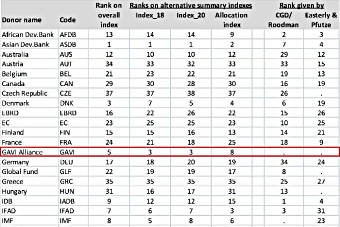
Source: Aid quality and donor rankings by Stephen Knack; F. Halsey; Nicholas Eubank, World Bank policy research working paper, May 2010 (Table 4).
GAVI's record on implementing the 2005 Paris Declaration on Aid Effectiveness ranks fifth amongst 38 bilateral and multilateral donors, according to a comprehensive and rigorous World Bank study.
Compared with previous donor rankings, the policy research paper uses a more exhaustive set of indicators to assess donor performance, combining existing criteria with new ones that better reflect the objectives of the Paris Declaration on Aid Effectiveness, such as alignment with country systems and harmonisation with other donors.
Related downloads
Firm commitment
The ranking reflects GAVI's firm commitment to delivering effective aid. In line with the Paris Declaration's emphasis on country ownership, national immunisation and health plans represent the starting point for all of GAVI's support to developing countries.
Representatives of donor and recipient countries signed the Paris Declaration in 2005 at a meeting convened in the French capital by the Organisation for Economic Cooperation and Development (OECD). The agreement, together with the follow-up 2008 Accra Agenda for Action, focused attention on common donor practices to help increase the impact of development aid.
Better quality aid
In line with the Paris Declaration, GAVI also actively promotes better quality aid, for example as a leading player in the International Health Partnership (IHP) and is working with other global programmes and the OECD in preparing for the next High Level Forum on Aid Effectiveness, scheduled to take place at Busan, Korea in late 2011.
Innovatory approach
Using 18 indicators derived from the OECD-DAC's Survey for Monitoring the Paris Declaration, the new AidData database, and the DAC aid tables, the new study's authors (Stephen Knack; F. Halsey; Nicholas Eubank) build an overall aid quality index and four coherently defined sub-indexes on aid selectivity, alignment, harmonization, and specialization.
This innovatory approach includes adjusting aid quality indicators to allow for recipient characteristics, donor aid volumes and other factors.
